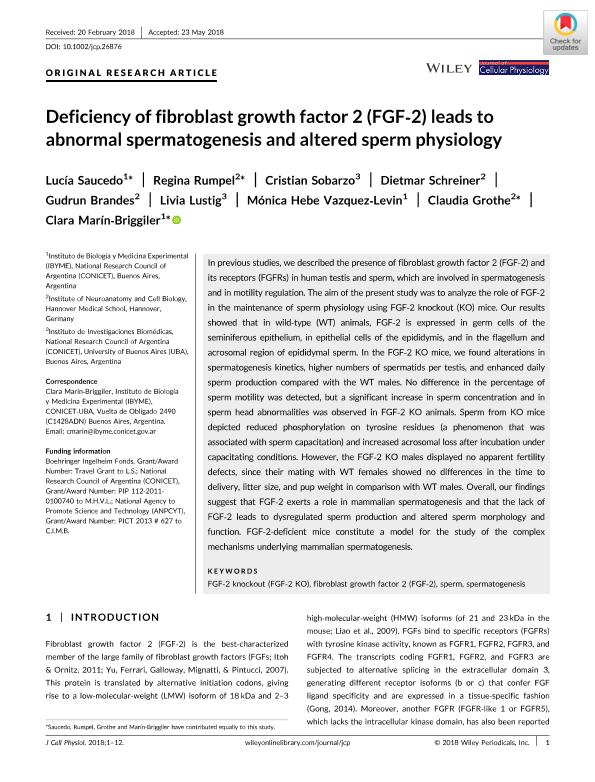Mostrar el registro sencillo del ítem
dc.contributor.author
Saucedo, Lucia

dc.contributor.author
Rumpel, Regina
dc.contributor.author
Sobarzo, Cristian Marcelo

dc.contributor.author
Schreiner, Dietmar
dc.contributor.author
Brandes, Gudrun
dc.contributor.author
Lustig, Livia

dc.contributor.author
Vazquez, Monica Hebe

dc.contributor.author
Grothe, Claudia
dc.contributor.author
Marin Briggiler, Clara Isabel

dc.date.available
2019-10-08T19:41:41Z
dc.date.issued
2018-12
dc.identifier.citation
Saucedo, Lucia; Rumpel, Regina; Sobarzo, Cristian Marcelo; Schreiner, Dietmar; Brandes, Gudrun; et al.; Deficiency of fibroblast growth factor 2 (FGF-2) leads to abnormal spermatogenesis and altered sperm physiology; Wiley-liss, Div John Wiley & Sons Inc; Journal of Cellular Physiology; 233; 12; 12-2018; 9640-9651
dc.identifier.issn
0021-9541
dc.identifier.uri
http://hdl.handle.net/11336/85370
dc.description.abstract
In previous studies, we described the presence of fibroblast growth factor 2 (FGF-2) and its receptors (FGFRs) in human testis and sperm, which are involved in spermatogenesis and in motility regulation. The aim of the present study was to analyze the role of FGF-2 in the maintenance of sperm physiology using FGF-2 knockout (KO) mice. Our results showed that in wild-type (WT) animals, FGF-2 is expressed in germ cells of the seminiferous epithelium, in epithelial cells of the epididymis, and in the flagellum and acrosomal region of epididymal sperm. In the FGF-2 KO mice, we found alterations in spermatogenesis kinetics, higher numbers of spermatids per testis, and enhanced daily sperm production compared with the WT males. No difference in the percentage of sperm motility was detected, but a significant increase in sperm concentration and in sperm head abnormalities was observed in FGF-2 KO animals. Sperm from KO mice depicted reduced phosphorylation on tyrosine residues (a phenomenon that was associated with sperm capacitation) and increased acrosomal loss after incubation under capacitating conditions. However, the FGF-2 KO males displayed no apparent fertility defects, since their mating with WT females showed no differences in the time to delivery, litter size, and pup weight in comparison with WT males. Overall, our findings suggest that FGF-2 exerts a role in mammalian spermatogenesis and that the lack of FGF-2 leads to dysregulated sperm production and altered sperm morphology and function. FGF-2-deficient mice constitute a model for the study of the complex mechanisms underlying mammalian spermatogenesis.
dc.format
application/pdf
dc.language.iso
eng
dc.publisher
Wiley-liss, Div John Wiley & Sons Inc

dc.rights
info:eu-repo/semantics/openAccess
dc.rights.uri
https://creativecommons.org/licenses/by-nc-sa/2.5/ar/
dc.subject
FGF-2 KNOCKOUT (FGF-2 KO)
dc.subject
FIBROBLAST GROWTH FACTOR 2 (FGF-2)
dc.subject
SPERM
dc.subject
SPERMATOGENESIS
dc.subject.classification
Biología Reproductiva

dc.subject.classification
Ciencias Biológicas

dc.subject.classification
CIENCIAS NATURALES Y EXACTAS

dc.title
Deficiency of fibroblast growth factor 2 (FGF-2) leads to abnormal spermatogenesis and altered sperm physiology
dc.type
info:eu-repo/semantics/article
dc.type
info:ar-repo/semantics/artículo
dc.type
info:eu-repo/semantics/publishedVersion
dc.date.updated
2019-09-27T15:22:37Z
dc.journal.volume
233
dc.journal.number
12
dc.journal.pagination
9640-9651
dc.journal.pais
Estados Unidos

dc.description.fil
Fil: Saucedo, Lucia. Consejo Nacional de Investigaciones Científicas y Técnicas; Argentina
dc.description.fil
Fil: Rumpel, Regina. Medizinische Hochschule Hannover ; Alemania
dc.description.fil
Fil: Sobarzo, Cristian Marcelo. Consejo Nacional de Investigaciones Científicas y Técnicas. Oficina de Coordinación Administrativa Houssay. Instituto de Investigaciones Biomédicas. Universidad de Buenos Aires. Facultad de Medicina. Instituto de Investigaciones Biomédicas; Argentina
dc.description.fil
Fil: Schreiner, Dietmar. Medizinische Hochschule Hannover ; Alemania
dc.description.fil
Fil: Brandes, Gudrun. Medizinische Hochschule Hannover ; Alemania
dc.description.fil
Fil: Lustig, Livia. Consejo Nacional de Investigaciones Científicas y Técnicas. Oficina de Coordinación Administrativa Houssay. Instituto de Investigaciones Biomédicas. Universidad de Buenos Aires. Facultad de Medicina. Instituto de Investigaciones Biomédicas; Argentina. Universidad de Buenos Aires; Argentina
dc.description.fil
Fil: Vazquez, Monica Hebe. Consejo Nacional de Investigaciones Científicas y Técnicas. Instituto de Biología y Medicina Experimental. Fundación de Instituto de Biología y Medicina Experimental. Instituto de Biología y Medicina Experimental; Argentina
dc.description.fil
Fil: Grothe, Claudia. Medizinische Hochschule Hannover ; Alemania
dc.description.fil
Fil: Marin Briggiler, Clara Isabel. Consejo Nacional de Investigaciones Científicas y Técnicas. Instituto de Biología y Medicina Experimental. Fundación de Instituto de Biología y Medicina Experimental. Instituto de Biología y Medicina Experimental; Argentina
dc.journal.title
Journal of Cellular Physiology

dc.relation.alternativeid
info:eu-repo/semantics/altIdentifier/url/https://onlinelibrary.wiley.com/doi/abs/10.1002/jcp.26876
dc.relation.alternativeid
info:eu-repo/semantics/altIdentifier/doi/http://dx.doi.org/10.1002/jcp.26876
Archivos asociados
